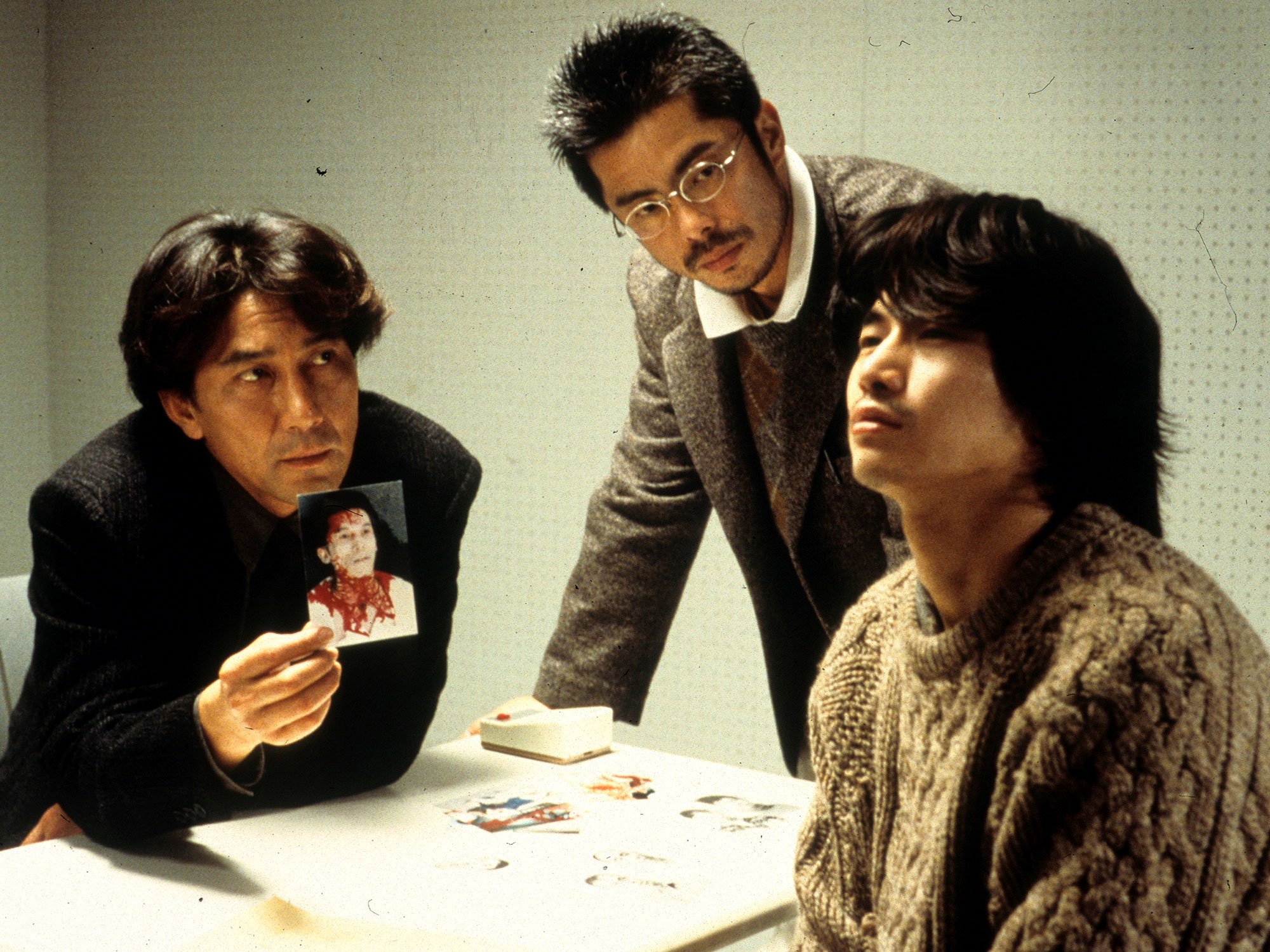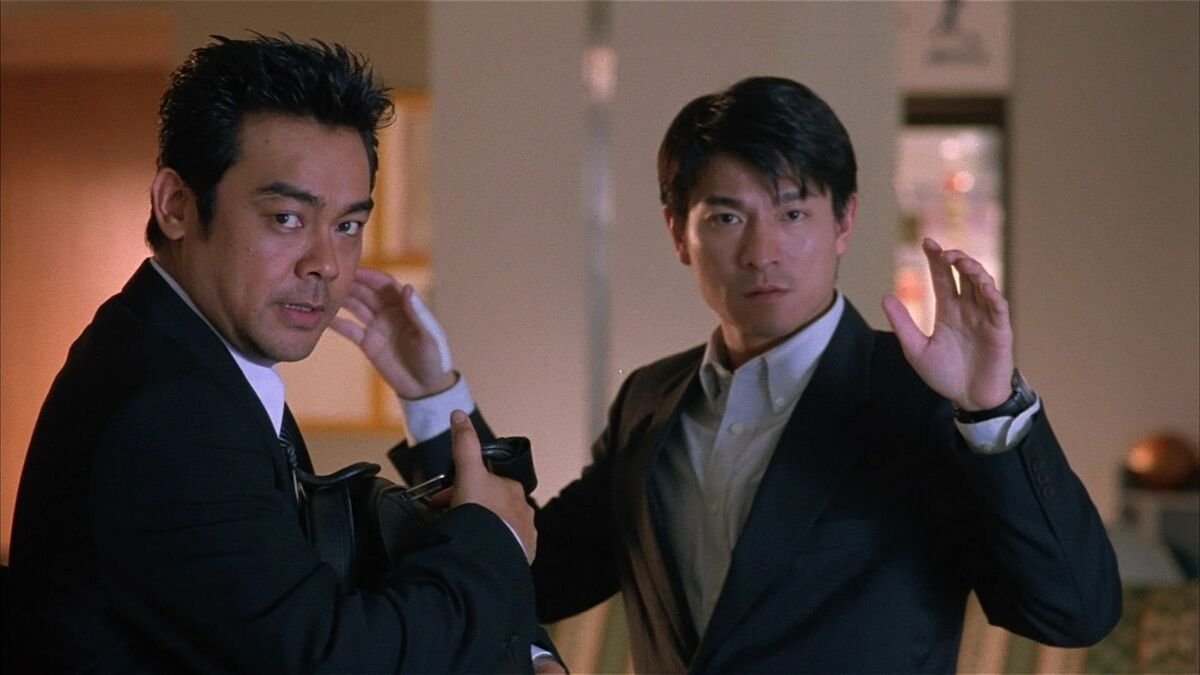Halloween Horror: Cure (1997)
Kiyoshi Kurosawa’s Cure is not your typical horror movie. It lacks jump scares, portentous music, stylized cinematography, and graphic violence. It doesn’t shift between quiet scenes meant to keep you off guard and scary scenes where you know horror is inevitable. A passive viewer might assume the film is simply an arthouse drama due to its tastefully distant cinematography and deliberate pacing. But it is undoubtedly a horror film. Like David Fincher’s Seven or George Sluizer’s The Vanishing, Cure forces the viewer to stare evil directly in the eye and see who blinks first. The resulting effect is as disturbing as anything you’ll find in more conventional horror pictures.
In the film, we watch detective Kenichi Takabe (Koji Yakusho) investigate a series of grisly murders, all connected in some way but seemingly perpetrated by different suspects. Victims are killed and left mutilated with an “X” carved into their necks. In every single case, a suspect is found and confesses, but there is no motive or explanation for their actions. Takabe believes there is a single killer pulling the strings. And he’s right.
Kurosawa reveals as much early on in the film, as we watch the amnesiac young man, Mamiya (Masato Hagiwara), in a series of encounters with people who go on to murder those around them. In some way, somehow, Mamiya is driving these people to kill. He seems as weak as anyone can be, but appearances are deceiving and, as the film ends up showing, even the most ordinary human being can hide deep wells of evil inside him or herself.
As Takabe investigates the killings, we learn about his fraught relationship with his wife (Anna Nakagawa), who struggles with mental illness. Takabe’s frustration at work is compounded by frustrations at home. Whenever he thinks he’s near a breakthrough, whether personally or professionally, a new problem arises and he’s the one left picking up the pieces. Koji Yakusho imbues Takabe with some classic hallmarks of the grizzled detective: he’s stoic in the face of violence, with a constantly-furrowed brow and seen-it-all professionalism. But there’s a frustration to Koji that is not the result of personal demons, such as alcohol or reckless abandon like other movie detectives. Rather, he is a man who is deeply angry because he believes that he has been wronged by those closest to him.
Cure sets Takabe, the frustrated man of action, on a collision course with Mamiya, the seemingly-hapless puppet master. The film’s fascinating tension and dark avenues of psychological exploration are a result of watching these two men interact. It’s rather conventional in horror to have the evil mastermind goad on the hero and push them towards depravity; both The Silence of the Lambs and the TV series Hannibal use this tension to fuel much of their dramatics. But no film or show does this in quite the way Cure does.
A great deal of this is due to the disarming presentation of Mamiya. Masato Hagiwara plays Mamiya as a waifish wisp of a man. When we first meet him, he plods about and plays like he doesn’t know who or where he is. His measly little moustache, oversized sweaters and jackets, and effeminate style make him seem weak when set against the stolid Takabe. He mumbles as he talks and his jet-black eyes seem perpetually glazed, unable to focus on anyone around him. He’s a man whose mind is adrift in a maelstrom and watching him is dizzying, as if by engaging with him, you’ll be uprooted and pulled into the storm yourself.
But such a performance is masterful misdirection. We eventually learn that Mamiya is a master hypnotist and he is hypnotizing his victims into committing murder. His hapless presentation is essential to making his victims lower their defences and suggestable to his hypnotic power. And when he does finally focus his jet-black eyes on other characters, and reveal that his incredible patience and stillness is an act, it’s terrifying.
Cure’s effect is the culmination of a number of elements. The filmmaking is tastefully at a remove for the early going; many scenes are shot in long takes of wide angles and we never get into the headspace of the characters in a visual sense. But there is a steady, constant drone, low on the soundtrack, a hypnotic ambience that acts as a throughline into the more nightmarish and subjective imagery that begins as the film progresses. We start to see inside the minds of characters, but Kurosawa never indicates as much at first. We simply see an individual walk into an old building and stare into the shadows or come face-to-face with a sinister version of a friend. Only in cutting back to reality do we realize we’re witnessing dreams.
Mamiya’s influence poisons the other characters and the tone of the film, like black ink spreading across crisp white letterhead. Kurosawa captures such a transformation in one stunning shot in Mamiya’s cell. Takabe stands over Mamiya and bares his soul and all his frustrations; as he pours out his venom, it begins to rain and we cut to a low angle shot looking up at the ceiling, with Takabe in the foreground and the ceiling the central focus of the background. Water spots appear and the ensuing leak spreads across the ceiling until the negative space seems to be touching Takabe’s head, a dark cloud forming over our hero. A darkness has appeared in Takabe’s thoughts, with no sign of light on the horizon.
As Takabe learns during his investigation, hypnotism cannot make a person do something they would never do while awake; it cannot override a person’s morality. And therein lies the troubling core of the film's exploration of evil. Like The Vanishing and Seven, the film explores the culpability of and capacity for evil in the ordinary person. The Vanishing challenges our prurient interest in details of death and destruction, which override our capacity to care for victims, while Seven shows how our sense of justice can easily make us the unwitting pawns of evil. Cure shows how evil is often lurking within us, ready to be activated, ready to be awoken—that so many of us are capable of profound evils, even drawn towards committing them, but simply need an external excuse to unleash them on the world.
The concept of Cure—detective investigates serial killer who uses hypnotism to make people commit murder—is ludicrous when described in writing, but the film’s exploration of this concept is riveting. It all leads to an ending of shocking moral descent, one that is so non-descriptly dark, blink and you’ll miss the implications of just what awful things you’ve seen. But such a subdued approach is why Cure is a great horror film. Its effect worms its way into your brain, casting a cloud like the metaphorical one that forms over Takabe. It does not overwhelm you with images and sounds of terror, but forces you to stare in the mirror and see the evil staring back at you from out of your own eyes. Because all the monsters in the real world, the ones that kill and maim and force evil upon themselves and others, are human beings—just like me and you.
9 out of 10
Cure (1997, Japan)
Written and directed by Kiyoshi Kurosawa; starring Koji Yakusho, Tsuyoshi Ujiki, Anna Nakagawa, Masato Hagiwara.



George More O’Farrell’s The Holly and the Ivy is a perceptive Christmas drama that deserves a place in the Christmas rotation.